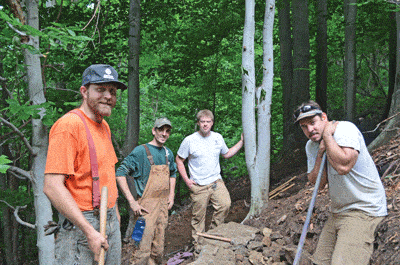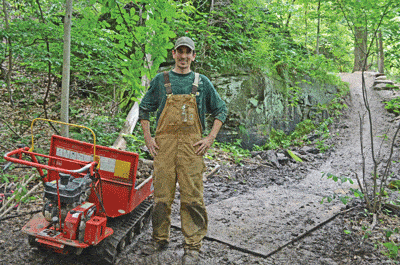Learn to Build Hiking, Mountain Bike Trails with the Cleveland Metroparks
There is a certain finesse required when rebuilding nature. It’s a fact you immediately understand watching Ralph Protano construct trails for the Cleveland Metroparks.
Park reservations like the 23,000-acre Metroparks in northeast Ohio require constant construction and maintenance, but they also require a deft and subtle hand — the ability to make man-made work look as if nature had a hand in building it. Protano is an expert at that balancing act. But as natural as these creations appear to the naked eye, these trails actually require the mechanical power of compact construction equipment to be built.
“Of course, a key to successful trail building is owning the right equipment, but it’s much more than that too,” says Protano, Cleveland Metroparks trails development manager. “In reality, it really boils down to sound design and layout practices. There is a major misconception out there that trail layout is simple work that can be completed quickly with little effort, so there’s this tendency to look for shortcuts, often because no one thought to budget the time, funds and equipment for the layout process.”
He’s been building trails for the Cleveland Metroparks since 2012, but his trail building experience started in 2009 with the Student Conservation Association in New Hampshire and Southern California. It continued with Off the Beaten Path — an accredited Professional Trail Builders Association contractor in New England — and working as a roving technician from southern Virginia to Maine for the Appalachian Trail Conservancy.

The Cleveland Metroparks trail crew is, from left, Mike Wallace, Ralph Protano, Kirby Weldon, Brad Muley and Mike Govang (not pictured).
Building the Crew
Protano and his crew have a plan, and they’d like to share it with you, Compact Equipment readers. They want to show us how compact machines and good design practices can build ideal trails for all types of recreation. Since the Cleveland Metroparks are basically in our own backyard, we went out to visit Protano on a project site in the Bedford Reservation.
Today, the Metroparks are comprised of 18 reservations surrounding Cleveland, mostly in Cuyahoga County. The bulk of the systems’ funding comes from taxes, so you had better believe they strive to get the most bang for their buck when completing projects.
Protano joined the system in 2012 and basically started the trails division. In those three years, he has slowly and methodically built a crew of five and amassed the equipment necessary to spearhead the creation of several all-purpose trails including the system’s first-ever purpose-built mountain biking path. Prior to its creation, mountain bikers looking for some satisfying off-road action either blazed their own trails or made do with bridle trails, both of which were frowned upon. But, that’s not his biggest challenge today.
“The most challenging part is moving our materials and getting to the work areas with minimal [soil] displacement,” Protano says. “Most everything we use is on tracks.”
When he started with the Metroparks, Protano ran solo, using a 1997 Dodge truck and used hand tools culled from the 18 reservations. Today, the crew counts among its equipment arsenal: a Caterpillar 300.9D mini excavator, a newly-acquired Canycom S25A heavy-duty tracked carrier, a pair of Canycom BFP602 walk-behind rubber track carriers and a variety of hand tools including a Hilti Combihammer. On our recent visit, the crew had the Combihammer out to hand cut its own stones for a hiking and mountain biking trail.
“Anyone performing the design and layout process needs to be well experienced in trail construction, maintenance and terrain assessments,” explains Protano. “Frankly, there are not a large number of such folks, so it’s important to train novices on every layout crew, particularly if you are not seeking outside help.”
It takes years of practice (not just one project) in the brush and mud to gain the type of experience necessary to be a competent trail designer. One of the most important things to learn: Keep with the natural theme. Protano and his crew take great pride in the fact that his division tries, as much as possible, to repurpose items for trail building, including wood for bridges or rocks removed during excavation and repurposed for retaining walls. In addition to what it has in its limited fleet, depending on the project, the trails crew borrows equipment from other Cleveland Metroparks divisions or rents.
Equipment Decisions
“The equipment we use is generated by the site,” Protano says. “We match the machine to the job.” Donations helped the crew procure its largest pieces of equipment. The 300.9D Caterpillar was purchased through the Emerald Necklace Endowment fund and the Canycom S25A was purchased with funds from the dedicated Cleveland Metroparks Trails Fund — primarily funded through the inaugural Beer at the Pier event in 2014.
These are the mainstays on every project thanks in part to their versatility. The mini excavator, with its adjustable tracks, is a perfect fit for the trails crew because of its size and ability to maneuver in and around tight areas.
“I like the 300.9D a lot, and I believe that when we first got it, there were few machines like it in its class [the ability to be so skinny and leave a small footprint]. That’s huge, because, I get into a lot of projects where not only are we trying to leave a small footprint on the ground, but we also strive to clear and disturb as few trees as possible in the process,” Protano says. “For that reason, it allows us to work really well in confined space. We try to restore everything we scratch up, too, so the mini, which may take us more time in terms of moving material around, is worth it in terms of the time saved by minimizing restoration at the end.”
When the crew adds a larger mini excavator to its fleet, Protano hopes to purchase a thumb to improve efficiency when working in the field.
Though new to the fleet, Protano sees the many benefits of the S25A crawler, namely its 180-degree pivoting dump box (essential when working in the woods and tight spaces) and its 5,500-lb payload. It can haul rocks and other debris from a worksite and haul in the essential non-wheeled equipment to wherever the crew is working.
“I think that Canycom really stands out as a brand. The BFP602 is almost like a trail staple. It’s tough, can carry good weight, manages itself on all types of terrains and slopes, simple to operate and it’s relatively easy to work on — especially in the field,” Protano says. “I’m pretty confident in the decision we made to get the 25A. Our [Cleveland Metroparks] golf construction crew already has a Yanmar in the park, and I think the Canycom better suits the trails crew’s needs.”
With Protano at the helm, and his employees pooling their varied experiences, the Cleveland Metroparks trails crew is merging the benefits of modern powered equipment and tried-and-true primitive hand-building methods to create unique trails that blend natural resource conservation and meet the needs of the community that frequents the park system.

